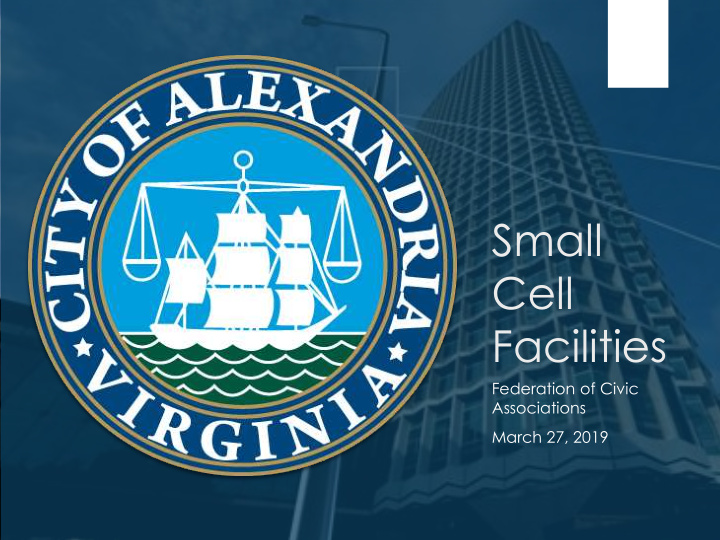



Small Cell Facilities Federation of Civic Associations March 27, 2019
AGENDA • What are Small Cells? • Needs, Benefits, & Concerns Legal Framework • What We Know • • Current Process • Work in Progress & Next Steps
What are Small Cells? • Small cells are low power wireless - MULTIPLE NODES SPREAD ACROSS CITY installations. - MOUNTED ON EXISTING INFRASTRUCTURE - CONNECTED BY FIBER Small cell antennas and • associated equipment can fit on existing utility or streetlight poles. Small cell antennas • needed to support S OURCE : T HE CBR G ROUP existing 4G networks, primarily in dense areas 3
Types of Small Cells Pole Top Mid Pole Base Pole 4
Need, Benefits & Concerns 5 The Need? Potential Benefits ▪ Increasing usage of wireless ▪ Increases mobile broadband devices and data; increased network service and capacity for demand requires reliable high- the community speed wireless service Economic competitiveness ▪ Increases opportunities to ▪ Concerns deploy smart city and IoT (Internet of Things) technology ▪ Pressure to greatly increase ▪ Robust wireless networks are number of equipment mounted critical to public safety as 80% of on existing poles national 911 calls are placed via ▪ Pole density will likely be wireless phones. substantially more as 5G deploys in future Carriers may prefer to own and ▪ operate their own poles and not co-locate on existing utility 5 poles, streetlights, etc.
Regulatory Rundown 6 VA General Assembly VA General Assembly adopts SB 1282 adopts HB 1258 and SB 405 Oct. 2017 Sep. 2018 Apr. 2017 July 2018 City Council approves zoning FCC issues second Declaratory text amendment to comply Ruling and Order with state regulations 6
Changes in Federal and State Law ▪ Virginia General Assembly enacted new statutes governing small cell zoning in 2017 and 2018. ▪ FCC issued two orders preempting local authority over wireless facilities in 2018. ▪ Special rules now apply to facilities to be installed at or below 50 feet in height these are deemed “small cell” or “small wireless facilities.” 7
Changes in Federal and State Law ▪ Under both federal and Virginia law, City is now subject to new rules governing: ▪ Deadlines for evaluating applications for siting small cell facilities, both in and out of the City’s rights -of- way ▪ Permitting fees ▪ Aesthetic standards that may be applied to a facility ▪ Undergrounding requirements ▪ In some cases, these may conflict 8
Effect on Legal Changes on City ▪ City applies “like for like” regarding pole replacement ▪ Zoning Ordinance regulations for small cell facilities will need to be updated to conform with new Virginia laws & FCC rules. ▪ Undergrounding policy limits installation of stand- alone poles and prohibits installation of new poles in ROW. ▪ Wireless carriers still need to obtain franchise agreements authorizing placement within City ROW. 9
10 What We Know Small Cells = Infrastructure 5G = Technology 10
11 What We Know About 5G 5G is the successor to current “4G” wireless technology; common ▪ “5G NR” technical standard was released in December 2018. 5G networks can support a larger number of devices than current ▪ networks – as reliance on smartphone apps increases, carriers will deploy 5G to support current services in high use areas as well as new services. ▪ Designed to improve connection speeds and reduce latency (internet response time). Lower latency is essential for advanced services, such as ▪ driverless cars. Carrier roll-out claims largely based on testing and marketing ▪ efforts. 5G smartphones available in 2019, but networks won’t be able to ▪ deliver new services until at least 2020 – assuming network in an area has been built. 11
12 What We Know Key points for the City: ▪ Current “4G/4G+” deployments are aimed at increasing capacity in high-use areas. 5G will come later, facilities are likely very similar. ▪ Networks are not truly wireless: Carriers need ROW access for fiber backhaul. ▪ Antennas are small enough to place on existing utility poles, but ancillary equipment is visible. ▪ Over long term, carriers may need antennas per block, at or below rooftop level. 12
13 What We Know Key points for the City: ▪ Each carrier and infrastructure provider has independent right to install facilities under Virginia law and FCC rules. ▪ Overall, both current (still 4G) and future (5G) equipment will supplement rather than replace existing networks. 13
14 Current Zoning Process ▪ Established in 2017 ▪ Guided by state law ▪ 60-day review period upon submission ▪ Routed to multiple city departments and agencies ▪ Deemed approved if final decision not rendered within 60-day review period (per state law). 14
15 Applications to Date ▪ City has received 21 applications since state law enacted in 2017. ▪ 3 applications have received zoning approval. 15
Current Work in Progress ▪ Meetings with community and stakeholders ▪ Staff is drafting proposed amendments to Zoning Ordinance to respond to Virginia law and FCC regulations ▪ Drafting interim aesthetic guidelines for small cell facilities that complies with regulations ▪ Reviewing current policies governing undergrounding, new poles, and replacement ▪ Exploring development of Smart Technology Framework ▪ Developing/revising internal staff guidance documents as appropriate 16
17 QUESTIONS? Richard Lawrence, AICP Richard.Lawrence@alexandriava.gov
Recommend
More recommend